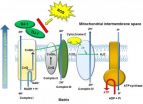(Press-News.org) EUGENE, Ore. -- Each tree species has its own bacterial identity. That's the conclusion of University of Oregon researchers and colleagues from other institutions who studied the genetic fingerprints of bacteria on 57 species of trees growing on a Panamanian island.
"This study demonstrates for the first time that host plants from different plant families and with different ecological strategies possess very different microbial communities on their leaves," said lead author Steven W. Kembel, a former postdoctoral researcher in the UO's Institute of Ecology and Evolution who is now a professor of biological sciences at the University of Quebec at Montreal.
For the research -- published this week in the online Early Edition of the Proceedings of the National Academy of Sciences -- researchers gathered bacterial samples from 57 of the more than 450 tree species growing in a lowland tropical forest on Barro Colorado Island, Panama.
Using DNA sequencing technology housed at the UO's Genomics Core Facility, scientists sequenced the bacterial 16S ribosomal RNA gene isolated from the samples. That gene, which biologists call a barcode gene, allowed researchers to identify and measure the diversity of bacteria based on millions of DNA fragments produced from bacterial communities collected from the surfaces of leaves, said Jessica Green, a professor at both the UO and Santa Fe Institute.
"Some bacteria were very abundant and present on every leaf in the forest, while others were rare and only found on the leaves of a single host species," Kembel said. "Each tree species of tree possessed a distinctive community of bacteria on its leaves."
In the world of microbiology, plant leaves are considered to be a habitat known as the phyllosphere. They are host to millions of bacteria, Kembel said. "These bacteria can have important effects -- both positive and negative -- on the health and functioning of their host plants," he said. "For example, while some bacteria on leaves cause disease, others may protect the plant against pathogens or produce hormones that increase plant growth rates."
In the animal microbiome, the researchers noted, studies comparing large numbers of species have shown that host diet -- for example, herbivory versus carnivory -- has a large effect on the structure of microbial communities in their guts. The new study, Kembel and Green said, provides a comparable understanding of the host attributes that explain patterns of microbial diversity in the plant microbiome.
"We found that the abundance of some bacterial taxa was correlated with the growth, mortality, and function of the host," Kembel said. These included bacteria involved in nitrogen fixing and the consumption of methane, as well as bacteria linked to soil and water.
Dominating the bacterial communities were a core microbiome of taxa including Actinobacteria, Alpha-, Beta- and Gamma-Proteobacteria and Sphingobacteria. Some types of bacteria, the researcher found, were more abundant when growing on the leaves of fast-growing or slow-growing tree species, or on leaves with different concentrations of elements such as nitrogen or phosphorous.
"Because of the importance of the microbiome for the growth and function of the host, understanding the factors that influence bacteria on the leaves of different trees could have important implications for our ability to model and conserve biological diversity and ecosystem function," Kembel said. "Ultimately, we hope that understanding the factors that explain variation in bacterial abundances across host species will help us better manage biological diversity in forests and the health and function of forest ecosystems."
INFORMATION:
Co-authors on the study with Green and Kembel are: Timothy K. O'Connor, a former technician in the UO Institute of Ecology of Evolution now at the University of Arizona; Holly K. Arnold, a former doctoral student in the UO Institute of Ecology and Evolution now at Oregon State University; Stephen P. Hubbell of the Smithsonian Tropical Research Institute in Panama and the University of California, Los Angeles; and S. Joseph Wright, of the Smithsonian Tropical Research Institute.
The Center for Tropical Forest Science of the Smithsonian Research Institute, Natural Sciences and Engineering Research Council of Canada, Canada Research Chairs Program, National Science Foundation, John D. and Catherine T. MacArthur Foundation, the Mellon Foundation and Small World Institute Fund were the leading supporters of the research.
Sources
Steven Kembel
Canada Research Chair and assistant professor
Department of Biological Sciences
University of Quebec at Montreal
514-987-3000 ext. 5855
kembel.steven_w@uqam.ca
Jessica Green
Associate professor of biology
University of Oregon
541-285-3562
jlgreen@uoregon.edu
The University of Oregon is equipped with an on-campus television studio with a point-of-origin Vyvx connection, which provides broadcast-quality video to networks worldwide via fiber optic network. In addition, there is video access to satellite uplink, and audio access to an ISDN codec for broadcast-quality radio interviews.
Links
Jessica Green: http://pages.uoregon.edu/green/
UO Genomics Core Facility: http://gcf.uoregon.edu/
Kembel lab: http://phylodiversity.net/skembel/
Abstract of the PNAS paper: http://www.pnas.org/content/early/2014/09/10/1216057111.abstract
Microbiome research shows each tree species has a unique bacterial identity
Gene sequencing of samples from 57 Panamanian tree species gives scientists a look at host diversity in the plant microbiome
2014-09-16
ELSE PRESS RELEASES FROM THIS DATE:
Molecular mechanisms of the suppression of axon regeneration by KLF transcription factors
2014-09-16
Molecular mechanisms of the Krüppel-like family of transcription factors (KLFs) have been studied more in proliferating cells than in post-mitotic cells such as neurons. Prof. Jeffrey L. Goldberg who comes from University of California San Diego, USA and his team recently found that KLFs regulate intrinsic axon growth ability in central nervous system (CNS) neurons including retinal ganglion cells, and hippocampal and cortical neurons. With at least 15 of 17 KLF family members expressed in neurons and at least 5 structurally unique subfamilies, it is important to ...
Give progesterone a chance
2014-09-16
There is currently no standard pharmacological treatment for spinal cord injury. Here, Dr. Florencia Labombarda, who comes from Buenos Aires University, Argentina suggests that progesterone, a steroid hormone, may be a promising therapeutical candidate as it is already for traumatic brain injury, where it has reached phase II clinical trials. We rely on previous works showing anti-inflammatory, neuroprotective and promyelinating roles for progesterone after spinal cord injury and in our recent paper, in which we demonstrate that progesterone diminishes lesion, preserves ...
The role of DJ-1 in the oxidative stress cell death cascade after stroke
2014-09-16
Oxidative stress is closely associated with secondary cell death in many disorders of the central nervous system including stroke, Parkinson's disease, Alzheimer's disease. Among many aberrant oxidative stress-associated proteins, DJ-1 has been associated with the oxidative stress cell death cascade primarily in Parkinson's disease. Although principally expressed in the cytoplasm and nucleus, DJ-1 can be secreted into the serum under pathological condition. Recently, a close pathological association between DJ-1 and oxidative stress in stroke has been implicated. To this ...
A heart-felt need for dairy food
2014-09-16
A daily small serve of dairy food may reduce the risk of heart disease or stroke, even in communities where such foods have not traditionally formed part of the diet.
A study of nearly 4000 Taiwanese, led by Emeritus Professor Mark Wahlqvist from Monash University's Department of Epidemiology and Preventive Medicine and the Monash Asia Institute, considered the role increased consumption of dairy foods had played in the country's gains in health and longevity.
"In a dominantly Chinese food culture, unaccustomed to dairy foods, consuming them up to seven times a ...
More cheese, please! News study shows dairy is good for your metabolic health
2014-09-16
This news release is available in French. Dairy is considered part of a healthy diet and dietary guidelines recommend the daily consumption of 2-4 portions of milk-based products such as milk, yogurt, cheese, cream and butter.
It's well known that dairy products contain calcium and minerals good for bones, but new research has shown that dairy consumption may also have beneficial effects on metabolic health and can reduce risk of metabolic diseases such as obesity and type 2 diabetes.
Curious about these impacts, researchers from CHU de Québec Research Center ...
Judging a fish by its color: for female bluefin killifish, love is a yellow mate
2014-09-16
VIDEO:
NYU Polytechnic School of Engineering researchers and their collaborators at University of Illinois at Urbana-Champaign found that fertile killifish females preferred swimming near a male replica that moved through the...
Click here for more information.
There's an old adage that warns against passing judgment based on appearance, but female bluefin killifish, like many animal species, apparently don't share such human wisdom when choosing a mate. Researchers at the New ...
Unraveling cell division
2014-09-16
This news release is available in Spanish. CRG researchers shed new light on mitosis. The study published in the Journal of Cell Biology describes how Topo 2 disentangles DNA molecules and is essential for proper cell division
At this very moment thousands of our body's cells are duplicating and dividing. This is the mechanism by which the body repairs damaged tissues and regenerates others like skin and hair. It involves a fairly complex process known as "mitosis", during which the cell duplicates its genetic material and separates it into two identical halves, which ...
Sam Houston State study examines use of GIS in policing
2014-09-16
HUNTSVILLE, TX (9/16/14) -- Police agencies are using Geographic Information Systems (GIS) for mapping crime, identifying crime "hot spots," assigning officers, and profiling offenders, but little research has been done about the effectiveness of the technology in curbing crime, according to a study at Sam Houston State University (SHSU).
"This review provides a reality check on the current status of GIS assessment in policing and the findings are not positive," said Yan Zhang, a SHSU professor and co-author of "Geographic Information System Effects on Policing Efficacy: ...
Do you always get what you pay for? How consumers mispredict product quality
2014-09-16
Consumers are willing to spend thousands of dollars for luxury brand watches such as Rolex and Cartier because they are synonymous with high quality. But does this mean that inexpensive watches made by low-cost rivals must always be low quality? According to a new study in the Journal of Consumer Research, consumers mistakenly predict product quality based on quality consistency in other price ranges.
"Highly consistent quality in one price range is enough for consumers to assume that quality can be predicted by price. Based on this belief, consumers assume high or low ...
Do ads showing sexy women make male consumers less charitable?
2014-09-16
What happens when you use images of sexy women to attract men's attention? According to a new study in the Journal of Consumer Research, male consumers who are shown images of sexy women feel less connected to other people and are less likely to purchase products advertised as benefiting others or make charitable contributions.
"Images of sexy women are ubiquitous in modern society and heavily used in advertising. Our primary focus is to show how exposure to pictures of sexy women could temporarily decrease the male consumer's sense of psychological connectedness with ...
LAST 30 PRESS RELEASES:
Jeonbuk National University study shows positive parenting can protect adolescents against self-harm
Surface-engineered ZnO nanocrystals to tackle perfluoroalkyl substance contamination
This new understanding of T cell receptors may improve cancer immunotherapies
A new fossil face sheds light on early migrations of ancient human ancestor
A new immunotherapy approach could work for many types of cancer
A new way to diagnose deadly lung infections and save lives
40 percent of MRI signals do not correspond to actual brain activity
How brain-inspired algorithms could drive down AI energy costs
Gum disease may be linked to plaque buildup in arteries, higher risk of major CVD events
Contrails are a major driver of aviation’s climate impact
Structure of dopamine-releasing neurons relates to the type of circuits they form for smell-processing
Reducing social isolation protects the brain in later life
Keeping the heart healthy increases longevity even after cancer
Young adults commonly mix cannabis with nicotine and tobacco
Comprehensive review illuminates tau protein's dual nature in brain health, disease, and emerging psychiatric connections
Book prepares K-12 leaders for the next public health crisis
Storms in the Southern Ocean mitigates global warming
Seals on the move: Research reveals key data for offshore development and international ecology
Sports injuries sustained during your period might be more severe
World's first successful 2 Tbit/s free-space optical communication using small optical terminals mountable on satellites and HAPS
Can intimate relationships affect your heart? New study says ‘yes’
Scalable and healable gradient textiles for multi‑scenario radiative cooling via bicomponent blow spinning
Research shows informed traders never let a good climate crisis go to waste
Intelligent XGBoost framework enhances asphalt pavement skid resistance assessment
Dual-function biomaterials for postoperative osteosarcoma: Tumor suppression and bone regeneration
New framework reveals where transport emissions concentrate in Singapore
NTP-enhanced lattice oxygen activation in Ce-Co catalysts for low-temperature soot combustion
Synergistic interface engineering in Cu-Zn-Ce catalysts for efficient CO2 hydrogenation to methanol
COVID-19 leaves a lasting mark on the human brain
Scientists use ultrasound to soften and treat cancer tumors without damaging healthy tissue
[Press-News.org] Microbiome research shows each tree species has a unique bacterial identityGene sequencing of samples from 57 Panamanian tree species gives scientists a look at host diversity in the plant microbiome


